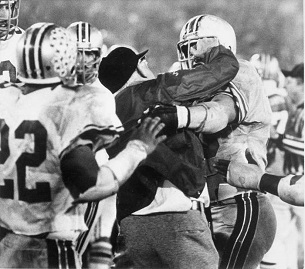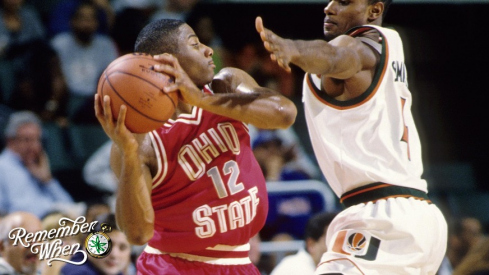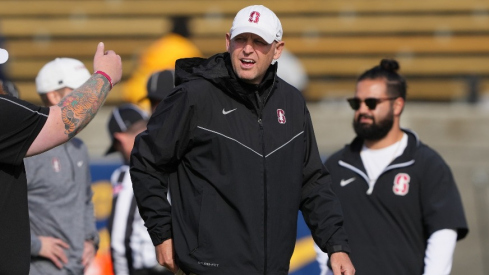
Doug Donley was open. Open for an easy touchdown. Donley was Art Schlichter's favorite receiver. Many times during the season, Schlichter had tried to force the ball to Donley when other receivers were open, resulting in incompletions or interceptions. This time the opposite occurred.
Was it the hand of Providence that caused Schlichter to ignore his favorite receiver and try forcing it to running back Ron Springs, thus leading to the fateful interception that led to the angry outburst that brought an end to the long coaching career of Woody Hayes? Could be. Or it could have just been inexperience and the result of an overbearing coach telling his freshman quarterback to throw short for the first down rather than take a chance on throwing downfield.
Whatever the reason, Schlichter missed Donley and threw to Springs, and the rest is history. Keith Jackson told the story of seeing Donley open on the play as he was speaking to a Columbus radio audience via telephone. Jackson has come under considerable fire, along with his broadcasting partner Ara Parseghian, for not mentioning "The Punch" as they were calling the action. Perhaps telling the story was Jackson's way of defending his claim that he never saw it.
Charlie Bauman, the recipient of the famous punch, claims that Jackson and Parseghian covered it up in order to keep Hayes from looking bad. The two men deny it. Whether it's true or not, it only adds to the legend. The 1978 Gator Bowl will always be remembered for The Punch and not for anything that happened on the field. That's unfortunate, because the game was a closely-fought contest, and one that Ohio State probably should have won.
The 1978 season was the swan song for the "Big Two and Little Eight" era in Big Ten football. While it is true that Ohio State and Michigan continued to be the best teams in the conference, it had become clear that other teams were now capable of playing with, and beating, the top teams on any given Saturday if they played well enough. Ohio State lost to Purdue that season while Michigan lost to Michigan State. Also, Michigan had been shut out by Minnesota the previous season. Parity had finally arrived in the Big Ten.
Still, because Purdue had a loss and a tie in the conference and Michigan State was on probation, the game between OSU and UM (who both had only one loss in the conference) would decide who went to the Rose Bowl. The loser would play #7 ranked Clemson in the Gator Bowl. For the third straight season, Michigan held Ohio State without a touchdown and defeated the Buckeyes, this time by the score of 14-3. As a result, OSU would have to be content to claim the consolation prize in Jacksonville.
As Vico has described, Hayes was matched up with a rookie coach in the bowl game. Danny Ford was only 30 years old when he took over the team to replace head coach Charley Pell, who had accepted the job as head coach at Florida. In fact, Ford was not just a rookie at the college level, he had never been a head coach at any level, and was matched up against a man who had spent 28 years at Ohio State alone. Nevertheless, Clemson was a two-point favorite in the game.
Hayes was known for making things difficult on his players during bowl trips, and this one was no exception. When bowl officials canceled the official run-through under the lights the night before the game due to excessive rain and wind, Hayes found a nearby high school that allowed him to use their facilities and went ahead with practice in the rain and mud. Since Jacksonville is on the east coast, Hayes was almost literally following his famous dictum to train in the Atlantic.
Hayes promised reporters that he was planning to throw the ball 25-30 times in the game, and he followed that up with passes on the first two plays of the game. On the second play, Schlichter hit Donley on the right sideline for a first down to loosen up the defense. It was effective, and Clemson was gashed on subsequent option runs by Schlichter and Springs. However, the drive stalled at the two-yard line and OSU turned it over on downs.
 Charlie Bauman wasn't the only player Hayes tangled with.
Charlie Bauman wasn't the only player Hayes tangled with.Clemson could not move the ball on their possession and they punted it back to the Buckeyes. This began a series of exchanges in which neither team could break the scoring ice. Ohio State dominated the first quarter but had nothing to show for it as they failed on yet another fourth down attempt from the Clemson 21. The quarter ended with the two teams tied 0-0, OSU having racked up 106 total yards to only 25 for Clemson.
By comparison, the second quarter was a scorefest. Ohio State started it by driving from their 30 to the Clemson 9 before settling for a 27-yard field goal. Clemson, led by the running and passing of quarterback Steve Fuller, responded with a long drive of their own, going 80 yards for a touchdown to take a 7-3 lead. The Buckeyes struck right back on a 78-yard touchdown drive with Schlichter running it in from four yards out. However, the extra point was blocked, and that would loom large later. Clemson kicked a 47-yard field goal just before halftime to take a 10-9 lead going into the break.
The third and fourth quarters were marked by long, time-consuming drives by one team that kept the ball away from the other. Clemson took their turn in the third (after four exchanges of possession), receiving the ball at their 16-yard line with 9:53 remaining in the quarter. They proceeded to drive 84 yards in 19 plays for a touchdown that increased their lead to 17-9, holding the ball for 7 minutes and 37 seconds in the process.
It was OSU's turn in the fourth, receiving the ball at their own 12 with 11:57 remaining. From there, they drove 88 yards on 12 plays with Schlichter once again carrying it in from two yards out for the score. But because they had missed the PAT earlier, Hayes elected to go for two on this touchdown to make up the difference. Schlichter optioned left to the short side and kept it, but he was met in the hole by Clemson defensive end Jim Stuckey and went down for no gain.
Ohio State got the ball back one more time with 4:22 left in the game when middle guard Tim Sawicki recovered a Clemson fumble at the Buckeye 24-yard line. From there, Schlichter drove the team smartly down the field, but faced a third-and-five from the Clemson 24 with just over two minutes remaining. The freshman quarterback dropped back to pass, scrambled a bit, then tried to hit Springs over the middle. Noseguard Bauman had not been able to penetrate the pass blocking in order to pressure Schlichter, and so he dropped back a few steps and rolled to his left, attempting to contain the scramble. This pursuit left him in perfect position to grab the pass thrown late over the middle, and he took the interception the way his momentum carried him, right into the OSU sideline. You know the rest.
Why did Schlichter not see his favorite receiver wide open on the same side where he had scrambled? For that matter, why did the famously conservative Hayes elect to throw the ball in that situation, when they were already in field goal position and a short run up the middle would have served his purposes and his personality better than a pass? The answers to these questions will never be known, and the whole game has been lost in history as all of the focus is on what happened on the sideline. It is still interesting, though, to contemplate what might have been.
Here's the game in its entirety.

